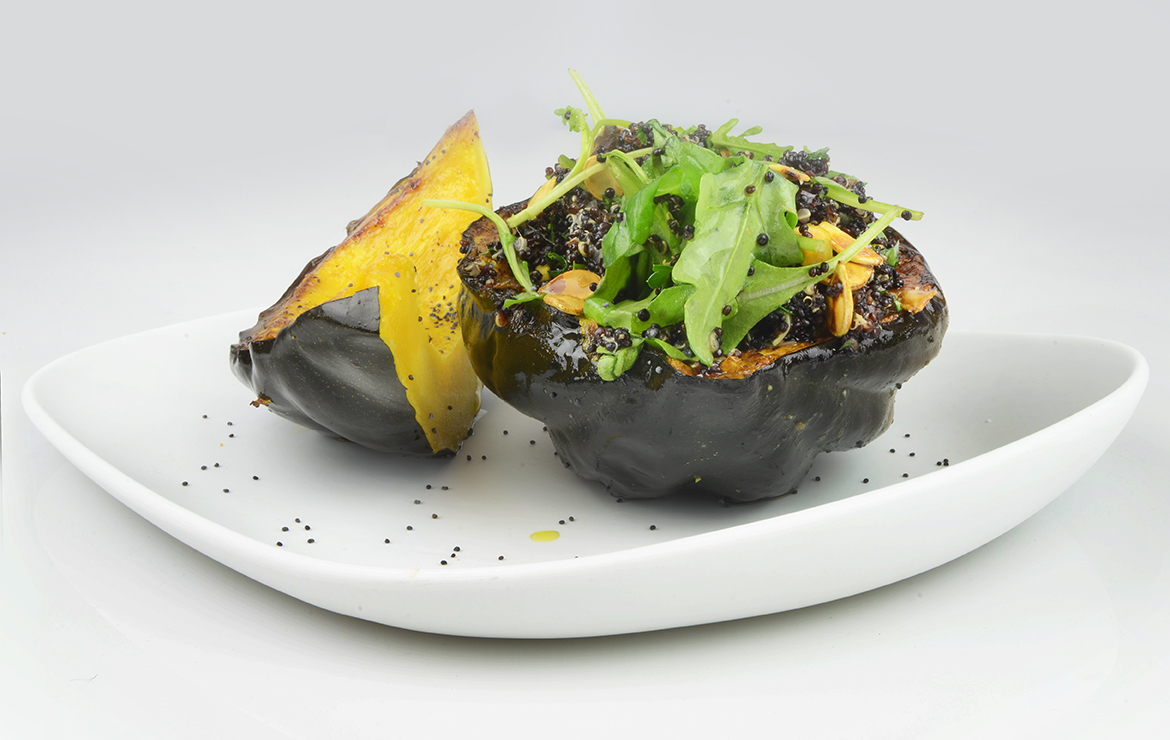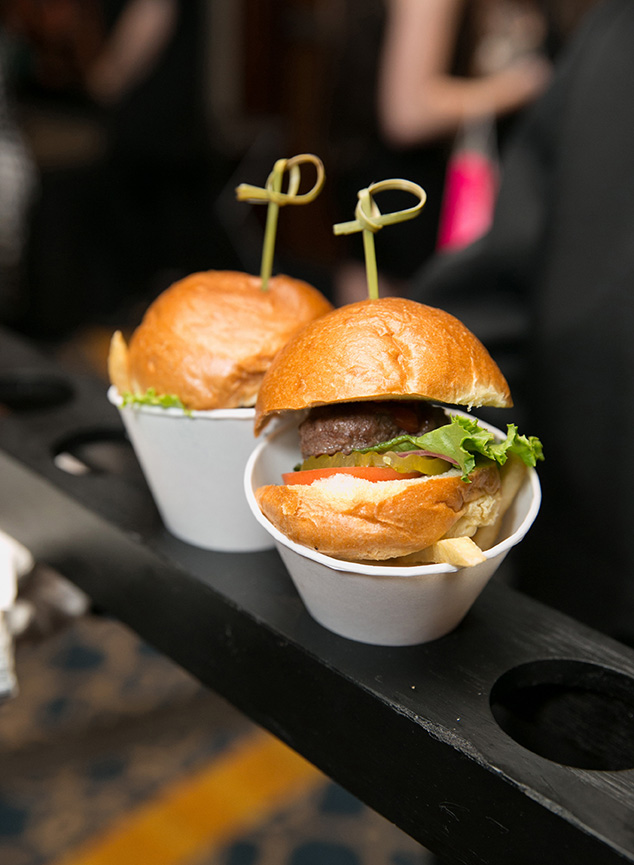In its humble beginnings, Jewish event catering was often characterized by what Michele Schwartz of the Modern Jewish Wedding Blog termed as its “boring yet safe” fare. Times, however, have changed. Heightened awareness, increased training, and innovative industry leadership have led to “a new elevated standard in kosher cuisine.”
According to Schwartz, caterers of the past “didn’t have a lot of kosher options to offer.” Alejandro Muguerza, President of Le Basque, Miami, FL, agrees, remarking that dated practices and resistance toward experimentation are yielding to “new culinary techniques that surfaced in the mid-90s and have continued to evolve through high profile American restaurants.”
Kosher caterers can now incorporate some of the industry’s most prominent trends. Says Tanya Shore, Event Planning Specialist at Simcha Sisters, Walnut Creek, CA, “Over the last several years, kosher restaurants and caterers have started offering locally grown and organic foods, vegan dishes, gluten free menus, and even sushi.” Cigall Goldman, Founder and CEO of MazelMoments, Forest Hills, NY has also observed that, “kosher cuisine continues to become more upscale and innovative in taste and presentation and is increasingly interactive, with [options such as] roll-around stations.”
Cherry Tomato Bonbon, Salmorejo Emulsion, Black Olive Dust, Green Olive Brioche. Photo courtesy Le Basque
Working with kosher clients
Clients expect caterers to have “a beyond the basics knowledge of what it means to keep kosher at the highest standard,” says Schwartz. She adds, “Clients want a caterer who can help navigate the complex relationship with the Vaad,” (council of rabbis).
“Kosher clients expect the same quality and innovation found in non-kosher menus but following the strict kosher guidelines,” says Muguerza. Shore adds that kosher clients “expect the event planner they work with to guide and manage caterers and other onsite support to ensure the event meets Kashrut standards. A good kosher caterer will be prepared to handle any event at any location.”

Black Quinoa Stuffed Acorn, Apples, Cranberries, Pistachio, Roasted Acorn Seeds. Photo courtesy Le Basque
Preparing your business
Where should catering professionals eager to serve the kosher catering market begin? For one, “You don’t need to be Jewish,” says Schwartz. However, you do need to be willing to learn. She recommends that caterers “create relationships with the Vaad, kosher meat providers, and understand the different hechshers, or kosher-approved symbols.”
Shore believes kosher caterers need to connect with a local synagogue and “invite the Rabbi to your venue to discuss how you can work together to provide kosher catering in your kitchen.” She also recommends getting kosher certification.
Muguerza knows that among the keys to success is having a kosher kitchen that is fully updated and functional and “creating menus of locally-available organic and seasonal ingredients.” When adherence to the rules prevents caterers from serving a particular dish, Goldman notes, “Pareve ingredients [which don't include any dairy or meat] can be used to recreate favorites.” Some examples of pareve ingredients are raw fruits and vegetables, flour, sugar, kosher fish, and eggs.

Mini sliders with shoestring fries from Gala Event and Food Artistry, Melville, NY. Photo: Denis DeLeon & Co
Kosher catering trends
Even exclusively kosher catering professionals need to keep up with broader industry trends. Muguerza suggests that teams brainstorm at the end of the season to determine what’s new and interest piquing in their region. He shares, “Every summer during the low season in south Florida, we regroup as a team and go over ideas and experiences that have come to our attention from a variety of sources. We brainstorm how to adapt and reinvent those elements to create our new seasonal and kosher menu concepts.”
Currently, eco-friendly as well as organic and locally grown items are popular, along with Fair Trade items, reports Shore.
Schwartz sees demand for “fully supervised kosher menus” declining in regions without large Orthodox Jewish populations, but feels that “kosher style is going to become even more popular, because it goes with the farm-to-table and vegetarian trends.”

Even nuts can be certified kosher. Photo courtesy Sante Nuts
Interfaith weddings
This new world of kosher catering is subject to the complexities of contemporary weddings in general. For example, “When dealing with an interfaith couple,” says Schwartz, “be respectful of the guests who do keep kosher. If there is an item that mixes meat and dairy (such as meat lasagna), offer a vegetarian option.”
Muguerza recognizes that it is “necessary to serve the strict kosher patrons from a totally separate kitchen and serve them with separate china, glassware, and silverware. It's also important to have a complete team dedicated toward accommodating their needs from chefs to waiters.”
If only a few guests are kosher, both Goldman and Shore recommend arranging to serve individually wrapped kosher meals that are pre-plated complete with silverware. Some meals must be served at room temperature to avoid heating in a non-kosher oven, so caterers should take appropriate measures to ensure proper handling.
Today’s kosher events can be just as lovely and filled with delicious food as any other wedding. As catering professionals, you simply need to take the time to prepare to serve the market and learn all you can.
Meghan Ely is president, OFD Consulting, Richmond, VA.
A KOSHER DIET
Kosher diets are part of the Kashrut, a Jewish law that specifies what foods can and cannot be eaten, as well as the way food is prepared and eaten. Food must be prepared with kosher utensils and dishes on kosher work surfaces.
Dietary regulations include, but are not limited to:
• Animals must be butchered in accordance with Jewish law
• All dairy products must come from kosher animals (such as: a land animal is kosher if it has split hooves and chews cud)
• Meat and dairy shall not be mixed
• Shellfish is forbidden
• Utensils for handling meat cannot cross-contaminate dairy
• Wine must come from a kosher source

Honeyed Blueberry Breakfast Blintzes
Yield: 8 servings
Ingredients
For the blintzes
4 eggs, lightly beaten
1 cup milk
1/3 cup matzo meal
1/3 cup potato starch
1/4 tsp salt
1/4 stick butter, for cooking the blintzes
2 T vegetable oil, for frying the blintzes
For the filling
1/4 cup honey
2 tsp vanilla
Zest of 1 orange
1/8 teaspoon cinnamon
4 oz cream cheese, softened
3/4 cup ricotta cheese
2 cups (12 oz) blueberries, divided
For the topping
Remaining 1 cup blueberries
Powdered sugar
Honey
Method
1. Whisk together the eggs, milk, matzo meal, potato starch and salt, refrigerate for one hour or overnight.
2. Stir together the honey, vanilla, orange zest, cinnamon, cream cheese, and ricotta. Fold in 1 cup of the blueberries. Refrigerate.
3. Melt the butter and vegetable oil together in a small bowl in the microwave. Heat a large non-stick pan over medium-high heat, swirl a spoonful of the butter and oil mixture over the surface of the pan.
4. Whisk the blintz batter to recombine then ladle about 2 oz of the batter into the pan, swirling the batter to cover the bottom of the pan in a thin layer. Cook for about 1-1/2 minutes or until the blintz begins to set and turn golden brown on the bottom. Flip the blintz over with a spatula and cook for an additional minute on the other side. Remove the blintz to a sheet pan and continue to cook all the batter.
5. Assemble the blintzes by placing 1/4 cup of the filling in the center, fold in both sides and roll up. Place blintzes in a shallow pan and reheat for 15 minutes in a 350°F oven or you can microwave them for 2–3 minutes. Place two blintzes on each plate and serve with additional blueberries, powdered sugar, and plenty of honey!
Tip: You can make the blintzes ahead of time and heat them up when you are ready to serve. Recipe courtesy of the National Honey Board
Tio Pepe Palomino Sherry Roasted Figs
with rosemary ice cream
Yield: 6 servings; recipe courtesy of Le Basque
Ingredients
For the shortbread cookies
1 cup all purpose flour
1/4 cup sugar
1/4 tsp salt
1/2 cup (1 stick) chilled unsalted kosher butter, cut into 1/2 inch cubes
For the honey-rosemary ice cream
2 cups almond milk
2/3 cup honey
1 (6-inch) fresh rosemary sprig
5 large egg yolks
Large pinch of fine sea salt
For the grilled fresh figs on rosemary skewers
4 stalks fresh rosemary, about 6 inches long
4 large firm ripe figs, any variety, stems trimmed, halved lengthwise
1/2 cup Tio Pepe Palomino Sherry
1/4 cup liquid honey
1 T lemon juice, freshly squeezed
Black pepper, to taste
Method
For the shortbread cookies
1. Preheat oven to 300 degrees F. Lightly butter 9-inch-diameter springform pan.
2. Whisk flour, sugar, and salt in medium bowl to blend.
3. Add 1/2 cup butter and rub in with fingertips until mixture resembles coarse meal. Gather dough together and form into ball; flatten into disk. Roll out dough on lightly floured surface until 1/2-inch-thick.
4. Transfer dough to prepared pan. Using fingers, press dough evenly over bottom to edges of pan. Using tip of small sharp knife, score dough into 8 equal triangles, then pierce all over with fork. Bake until shortbread is cooked through and pale golden, about 45 minutes.
For the honey-rosemary ice cream
1. Combine almond milk, honey, and rosemary in large saucepan. Stir over medium heat until small bubbles form around edges of pan. Remove from heat; cover and let set 30 minutes. Discard rosemary.
2. Reheat cream mixture to simmer; remove from heat. Whisk yolks and sea salt in medium bowl. Gradually add hot cream mixture; whisk until blended.
3. Return custard to same saucepan and stir over medium-low heat until custard thickens slightly and coats back of spoon when finger is drawn across and instant-read thermometer inserted into custard registers 165 F to 170 F, 4 to 5 minutes (do not boil). Strain into medium bowl.
4. Set bowl over large bowl filled with ice and water; stir occasionally until cool, about 10 minutes. Remove bowl from ice and water. Cover custard with plastic wrap and chill in the freezer at least 4 hours.
For the grilled fresh figs on rosemary skewers
1. Strip the leaves from the bottom of the rosemary stems, leaving about 1 1/2 inches of leaves at the tip. Finely chop 2 tablespoons of the stripped rosemary leaves and set them aside.
2. Place the stems in a bowl and add cold water to cover; soak for at least 30 minutes.
3. Drain the stems and pat dry with paper towel. Skewer 2 fig halves crosswise on each rosemary stem. Arrange the skewers on a plate with the cut sides of the figs facing up.
4. In a small bowl, mix together sherry, honey, and lemon juice. Brush the honey/lemon mixture over the cut side of the figs. Preheat the broiler or grill to medium-high. Grill or broil the figs until they are lightly browned and softened, about 1 to 2 minutes per side.
5. Sprinkle evenly with the reserved rosemary leaves and some black pepper. Serve on the skewers while still hot.
Assembly
Crumble one spoonful of the shortbread onto a plate. Place one scoop of the Honey-Rosemary ice cream on top of the crumble. Place one skewer with three figs behind the shortbread crumble and ice cream. Recipe courtesy of Le Basque Catering, Miami, FL



